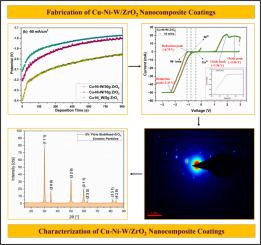电沉积Cu-Ni-W/ZrO2金属基纳米复合镀层的组织、微观结构及成分分析
IF 5.5
2区 材料科学
Q1 MATERIALS SCIENCE, CHARACTERIZATION & TESTING
引用次数: 0
摘要
该研究探讨了沉积参数,特别是ZrO2颗粒的数量和电流密度对Cu-Ni-W/ZrO2金属基纳米复合涂层的结构、微观结构和成分属性的影响,并将其作为先进材料配方。采用直流电沉积法制备了Cu-Ni-W合金为基体,并以8mol %钇稳定的ZrO2陶瓷颗粒增强的纳米复合镀层。从高分辨率透射电镜分析中获得的选定区域电子衍射图证实了复合基体中存在多个ZrO2晶体相。衍射斑点分布在四方相的(101)、(002)、(222)、(331)和(114)晶面上,而单斜相则分布在(- 202)和(031)晶面上。此外,(420)衍射面与ZrO2的立方相有关。x射线衍射分析证实了Cu-Ni-W在2θ值43.7°、50.9°和74.2°处存在特征衍射峰,这些特征衍射峰属于Cu-Ni-W面心立方结构的(111)、(200)和(220)面。场发射扫描电镜图像表明,涂层由高度精细、致密和无裂纹的形貌组成,厚度为~ 340至420 nm。能量色散光谱的研究结果证实,涂层富含铜,含Cu 69-90 wt%, Ni 2-19 wt%和W 1-5 wt%。此外,在复合涂层中发现掺入ZrO2陶瓷颗粒的浓度在1%到9%之间变化。当电解液中ZrO2浓度从5 g/L增加到30 g/L时,Cu-Ni-W /ZrO2 MMNC涂层的机械性能得到改善,压痕深度从76 nm减少到51 nm,硬度增加到5.5 GPa。ZrO2纳米颗粒的最大弹性模量为110 GPa,归因于相多样性、晶粒细化和刚性增强。本文章由计算机程序翻译,如有差异,请以英文原文为准。

Structure, microstructure and compositional analysis of electrodeposited Cu-Ni-W/ZrO2 metal matrix nanocomposite coatings
The study explored the impact of deposition parameters, particularly the amount of ZrO2 particles and current density, on structure, microstructure and compositional attributes of Cu-Ni-W/ZrO2 metal matrix nanocomposite coatings for their formulation as advanced materials. Nanocomposite coatings composed of Cu-Ni-W alloy matrix, reinforced with 8 mol% yttria-stabilized ZrO2 ceramic particles, were successfully synthesized using the direct current electrodeposition method. The selected area electron diffraction patterns obtained from high-resolution transmission electron microscopy analysis have confirmed the presence of multiple crystallographic phases of ZrO2 within the composite matrix. The diffraction spots were assigned to the (101), (002), (222), (331), and (114) crystallographic planes of the tetragonal phase, whereas the monoclinic phase was identified by the (−202) and (031) diffraction planes. Additionally, the (420) diffraction plane was associated with the cubic phase of ZrO2. The X-ray diffraction analysis confirmed the presence of characteristic diffraction peaks at 2θ values of 43.7°, 50.9°, and 74.2°, which were attributed to the (111), (200), and (220) planes of the face-centred cubic structure of Cu-Ni-W. The field emission scanning electron microscopy images indicated that coatings consist of a highly refined, compact, and crack-free morphology with thickness of ∼340 to 420 nm. The findings from Energy Dispersive Spectroscopy confirmed that coatings were rich in copper, containing Cu 69–90 wt%, Ni 2–19 wt%, and W 1–5 wt%. Additionally, the concentration of incorporated ZrO2 ceramic particles was found to vary between 1 and 9 wt% in the composite coatings. The Cu–Ni–W/ZrO2 MMNC coatings demonstrated improved mechanical characteristics, as evidenced by a reduction in indentation depth from 76 to 51 nm and an increase in hardness to 5.5 GPa with the rise in ZrO2 concentration from 5 to 30 g/L in the electrolyte. The maximum elastic modulus of 110 GPa, was attributed to phase multiplicity, grain refinement, and the rigid reinforcement of the ZrO2 nanoparticles.
求助全文
通过发布文献求助,成功后即可免费获取论文全文。
去求助
来源期刊

Materials Characterization
工程技术-材料科学:表征与测试
CiteScore
7.60
自引率
8.50%
发文量
746
审稿时长
36 days
期刊介绍:
Materials Characterization features original articles and state-of-the-art reviews on theoretical and practical aspects of the structure and behaviour of materials.
The Journal focuses on all characterization techniques, including all forms of microscopy (light, electron, acoustic, etc.,) and analysis (especially microanalysis and surface analytical techniques). Developments in both this wide range of techniques and their application to the quantification of the microstructure of materials are essential facets of the Journal.
The Journal provides the Materials Scientist/Engineer with up-to-date information on many types of materials with an underlying theme of explaining the behavior of materials using novel approaches. Materials covered by the journal include:
Metals & Alloys
Ceramics
Nanomaterials
Biomedical materials
Optical materials
Composites
Natural Materials.
 求助内容:
求助内容: 应助结果提醒方式:
应助结果提醒方式:


